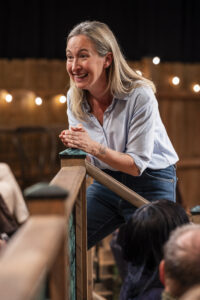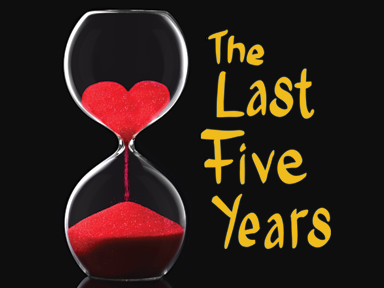
 **** Jessie Fisher is vivacious and engaging in this cleverly conceived and remarkably well-acted one-hander “Every Brilliant Thing.” Cultivating an attitude of gratitude is a major theme in this play, written by Duncan Macmillan with Jonny Donahoe. It is also the story of what it means to be a child whose parent suffers from suicidal ideation and is periodically in and out of the hospital. This creatively inspired and nicely accomplished show navigates between joyfulness and sadness, often at the same moment.
**** Jessie Fisher is vivacious and engaging in this cleverly conceived and remarkably well-acted one-hander “Every Brilliant Thing.” Cultivating an attitude of gratitude is a major theme in this play, written by Duncan Macmillan with Jonny Donahoe. It is also the story of what it means to be a child whose parent suffers from suicidal ideation and is periodically in and out of the hospital. This creatively inspired and nicely accomplished show navigates between joyfulness and sadness, often at the same moment.
The play takes us on a journey of an individual’s life. The story starts in 1987 when the unnamed main character is seven years old. This is the first time her mother is taken to the hospital, shortly after her failed suicide attempt. Prior to this moment, the only real tragedy in the character’s life was having to put her dog down. But now, the child becomes inspired to write a list of all of the brilliant things that make life worth living, initially to counteract her own sadness. But soon she gets the great idea of sharing this list with her mother in order to make her feel happy. And the list begins with ice cream, water fights, and staying up past your bedtime and being allowed to watch TV. Brilliant things begin with simplistic ideas, and the list moves throughout the character’s lifetime to become statements both beautiful and complex. We see how the focus changes as the child morphs into a teen and from a teen into adulthood. All throughout the performance, we watch how her list grows and grows….
The play touches upon a situation when a child might blame themselves for their parent’s depression when it has nothing to do with them. In this case, the main character as a seven-year-old, an eleven-year-old, and a high school student has not yet learned an important lesson: that it doesn’t make her mother feel any less sad or depressed when she is presented with a list of brilliant things and told that she has so much to live for. More generically, the story describes how we try to make ourselves feel better by trying to make another person happier. If that person responds positively, then it’s a benefit to us too. But what happens if they don’t pay attention to us in the first place?
Fisher has had to memorize an incredibly long and involved text, and her delivery is exceptional! But this play is not entirely a one-person monologue. Fisher has a talent for picking out just the right audience members who can bolster her story and then hints at how they should respond to her. They become her foil characters. Not only does this device individualize every performance, but it holds everybody’s interest. The night I was there, she chose several people, perfect for playing the parts of significant individuals during several points in her life, such as her father, her counselor in elementary school, and a veterinarian. In addition, Fisher passes out slips of paper to the audience in advance and subsequently provides each of us with the opportunity to read a given line when called upon. The numbers on the slips become clear within the context of the performance when she wants us to think about the size of her list and dwell upon all those things in life that she has deemed positively wonderful.
The relative smallness of the Gillian Theatre (at Writers Theatre) combined with the immersive nature of the production creates a unique opportunity for the audience to become a part of the character’s life. In this vein, Kimberly Senior’s direction is right on the mark. She has Fisher move throughout the space and even up into the theatre seats as she speaks her monologues. Senior has neatly arranged things such that members of the audience who interact with the character can be seen by all.
Set design by Izumi Inaba and prop design by Rae Watson are great. We see a patio with outdoor furniture, casual chairs, and cabaret tables. There is (fake) grass on the ground and a wooden plank fence on two sides of the set. We also see a Kimball spinet piano and bench and, on the other side of the room, a phonograph and vinyl records. Lighting design by Jason Lynch is perfect for this show. Two Tiffany lamps, strings of white lights, and lots of paper lamps hang from the ceiling, and there are also several translucent windows that emanate light. Most importantly, the house lights never dimmed until Fisher is ready to take her bows. Sound design by Angela Baldasare and Mikhail Fiksel includes the sounds of recorded music, once enjoyed by the main character’s father. Additionally, a short hallway outside the Gillian Theatre door features a large number of brilliantly colored post-it notes and several pens. Messages of gratefulness have been posted on the wall throughout, and members of the audience are encouraged to add their own notes about brilliant things that resonate with them.
Macmillan’s reason for writing the play was to tell people “You’re not alone, you’re not weird, you will get through it, and you’ve just got to hold on. That’s a very uncool, unfashionable thing for someone to say, but I really mean it. I didn’t see anyone discussing suicidal depression in a useful or interesting or accurate way.” This story could have been very morose, but the use of the list as a prop helps to educate all of us about suicide in a lighthearted manner. In the course of watching the performance, we see how the main character has lived her life from the perspective of the list as well as from the perspective of the books that she has subsequently read. Only as an adult (spoiler alert) does she realize that the list was actually for herself. This coincides with the character’s own mental health issues and the fact that her marriage didn’t work out. Thus, despite keeping the list and constantly adding to it, she nevertheless discovers that her search for joyfulness in life has been elusive.
In the context of the show (and via the playbill), we learn a bit about resources available so that people don’t have to suffer from the “contagion” of depression and suicide. The production also demonstrates the importance of reaching out to others when it comes to mental health concerns and not being afraid to seek professional help. By including the audience as characters in the performance, this helps propel the story with a powerful energy that drives these points home in a clear and coherent way.
“Every Brilliant Thing” is playing through January 5, 2025, at Writers Theatre, 325 Tudor Court, Glencoe, Illinois, inside their Gillian Theatre.
General admission tickets are $70.
Performance schedule:
Tuesday performances at 2:00 p.m. only on December 24 and 31.
Wednesdays – 3:00 p.m. and 7:30 p.m.
No Wednesday matinee performances on November 27 and December 4
No Wednesday performances on December 25 (Christmas Day) and January 1 (New Year’s Day)
Thursdays – 7:30 p.m. No performance on Thursday, November 28 (Thanksgiving Day)
Fridays – 7:30 p.m.
Saturdays – 3:00 p.m. and 7:30 p.m.
Sundays – 2:00 p.m.
Additional Sunday performances at 6:00 p.m. on December 1, 8, 22, and 29, and January 5.
Note that many of these performances are already sold out or there is limited seating.
“You will not have an assigned seat. There will be a variety of seating options to choose from when you arrive: traditional theatre seats, sofas and armchairs, patio/lawn chairs, and cabaret table seating.”
“Subscribers will be given priority access to the theatre and can begin entering 30 minutes before show time. All other ticket buyers can begin accessing the theatre 15 minutes before show time.”
For more information, go to: https://www.writerstheatre.org/every-brilliant-thing.
To purchase tickets, see: https://my.writerstheatre.org/events or call 847-242-6000.
For general information and a list of their other offerings, visit: https://www.writerstheatre.org/2425-season
To see what others are saying, visit www.theatreinchicago.com, go to Review Round-Up and click at “Every Brilliant Thing”.






More Stories
“The Last Five Years” MILWAUKEE
“The Trial of Themistocles” reviewed by Julia W. Rath
“Titanique”